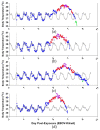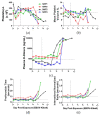Natural History of Aerosol-Induced Ebola Virus Disease in Rhesus Macaques
- PMID: 34835103
- PMCID: PMC8619410
- DOI: 10.3390/v13112297
Natural History of Aerosol-Induced Ebola Virus Disease in Rhesus Macaques
Abstract
Ebola virus disease (EVD) is a serious global health concern because case fatality rates are approximately 50% due to recent widespread outbreaks in Africa. Well-defined nonhuman primate (NHP) models for different routes of Ebola virus exposure are needed to test the efficacy of candidate countermeasures. In this natural history study, four rhesus macaques were challenged via aerosol with a target titer of 1000 plaque-forming units per milliliter of Ebola virus. The course of disease was split into the following stages for descriptive purposes: subclinical, clinical, and decompensated. During the subclinical stage, high levels of venous partial pressure of carbon dioxide led to respiratory acidemia in three of four of the NHPs, and all developed lymphopenia. During the clinical stage, all animals had fever, viremia, and respiratory alkalosis. The decompensatory stage involved coagulopathy, cytokine storm, and liver and renal injury. These events were followed by hypotension, elevated lactate, metabolic acidemia, shock and mortality similar to historic intramuscular challenge studies. Viral loads in the lungs of aerosol-exposed animals were not distinctly different compared to previous intramuscularly challenged studies. Differences in the aerosol model, compared to intramuscular model, include an extended subclinical stage, shortened clinical stage, and general decompensated stage. Therefore, the shortened timeframe for clinical detection of the aerosol-induced disease can impair timely therapeutic administration. In summary, this nonhuman primate model of aerosol-induced EVD characterizes early disease markers and additional details to enable countermeasure development.
Keywords: Ebola; Kikwit; Macaca mulatta; Zaire; aerosol; cytokine storm; natural history; respiratory alkalosis; rhesus macaque; telemetry; viral hemorrhagic fever; virus.
Conflict of interest statement
The authors declare no conflict of interest.
Figures








References
-
- WHO Ebola Virus Disease. [(accessed on 13 September 2020)]. Available online: https://www.who.int/news-room/fact-sheets/detail/ebola-virus-disease.
Publication types
MeSH terms
Substances
LinkOut - more resources
Full Text Sources
Medical

